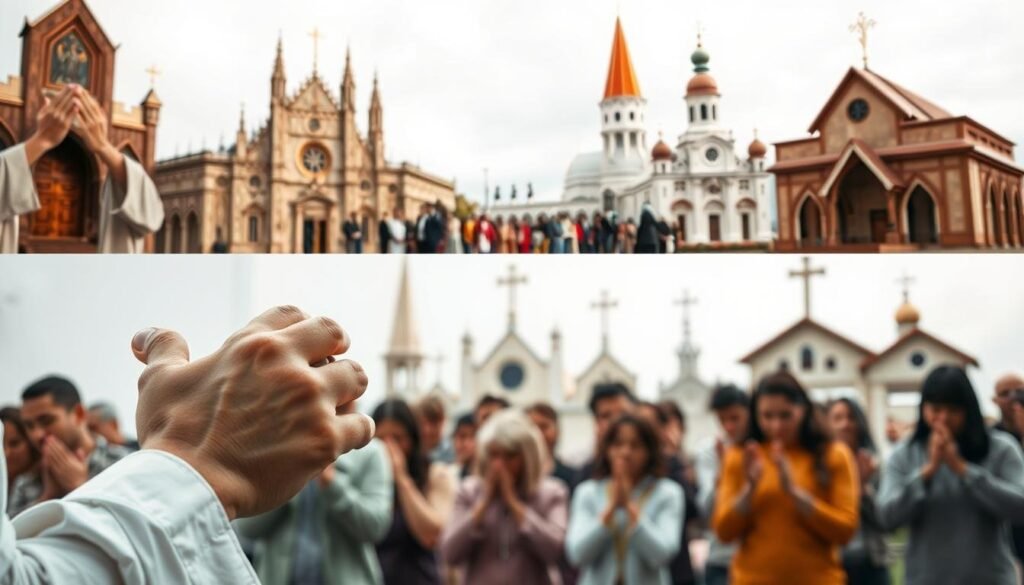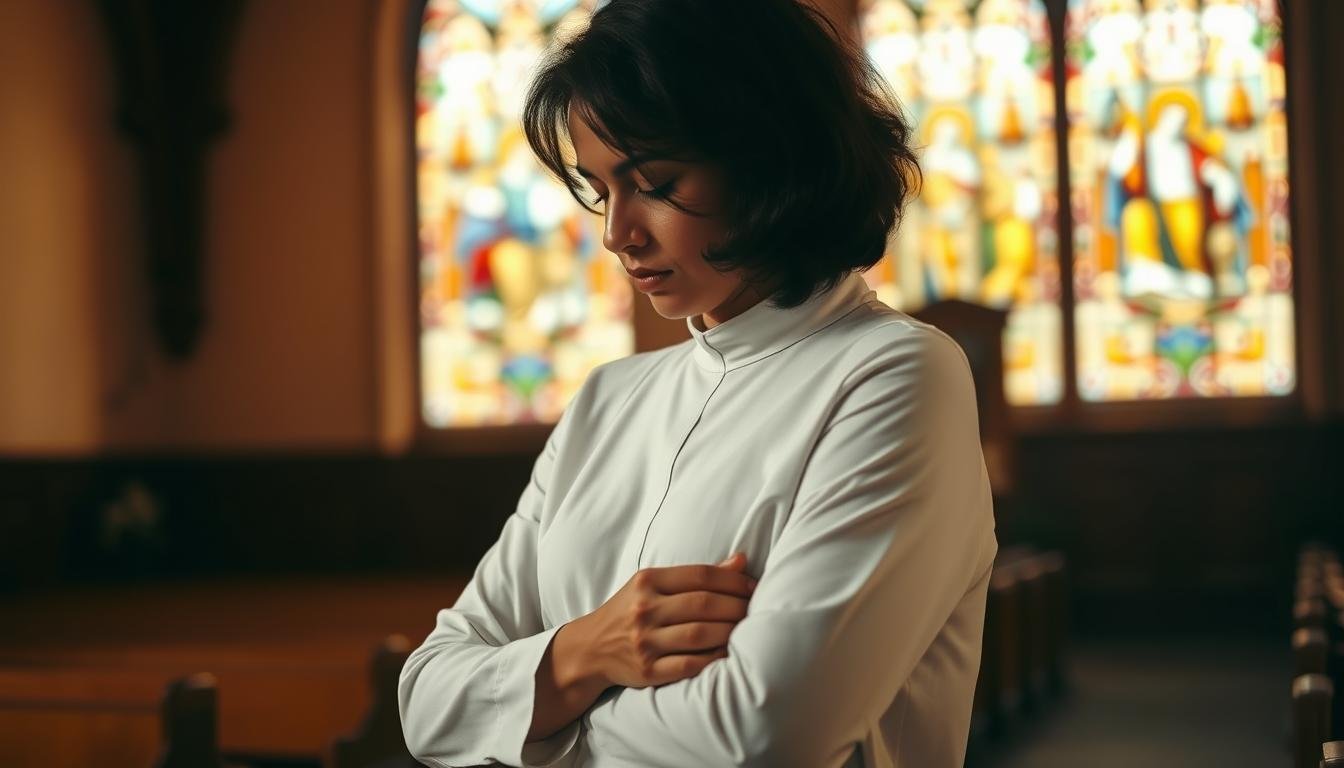Last updated on October 21st, 2025 at 03:51 pm
Why Do Mormons Cross Their Arms When Praying? Have you ever noticed how members of The Church of Jesus Christ of Latter-day Saints, or Mormons, pray? They often cross their arms. This is a key part of Latter-day Saint worship.
Learning about this practice can help you understand its spiritual value. The act of crossing arms is not just a physical action. It holds deep spiritual meaning in their worship.
Discovering why Mormons pray this way can deepen your respect for their rituals. It shows the importance of crossed arms prayer in their beliefs.
Contents
- 1 The Prayer Posture in Latter-day Saint Worship
- 2 Why Do Mormons Cross Their Arms When They Pray?
- 3 Historical Origins and Development
- 4 Theological Significance and Symbolism
- 5 Teaching and Passing Down the Practice
- 6 Prayer Postures Across Different Worship Settings
- 7 Conclusion: Why Do Mormons Cross Their Arms When Praying?
- 8 FAQ
- 8.1 Why do Mormons cross their arms when praying?
- 8.2 Is crossing arms during prayer a unique practice to the Latter-day Saint faith?
- 8.3 How is the prayer posture taught to children in the Latter-day Saint community?
- 8.4 How does the Latter-day Saint prayer posture compare to other Christian denominations?
- 8.5 What is the significance of uniformity in the Latter-day Saint prayer posture?
- 8.6 How has the Mormon prayer posture evolved over time?
The Prayer Posture in Latter-day Saint Worship
At a Latter-day Saint worship service, you’ll see everyone praying the same way. This shows how much they value unity and respect in their worship. [Why Do Mormons Cross Their Arms When Praying?]
The prayer posture includes bowing your head, closing your eyes, and crossing your arms. It’s more than just a gesture. It shows respect, humility, and devotion to their faith.
The meaning behind this posture is deep. Bowing your head and closing your eyes show respect and focus on the spiritual. Crossing your arms shows humility and respect.
| Posture Component | Symbolic Meaning |
|---|---|
| Bowing Head | Reverence and Humility |
| Closing Eyes | Focus on the Spiritual |
| Crossing Arms | Respect and Devotion |
Learning about the prayer posture in Latter-day Saint worship helps us understand their beliefs. It shows how important unity and reverence are in their religious practices. [Why Do Mormons Cross Their Arms When Praying?]
Why Do Mormons Cross Their Arms When They Pray?
To understand why Mormons cross their arms when praying, we need to look at their beliefs and practices. This custom is deeply rooted in their scripture, tradition, and cultural influences.
Crossing arms during prayer is a key part of Mormon worship. It shows their reverence, obedience, and spiritual expression. This act is not just a physical gesture but holds deep theological meaning.
The Role of Scripture and Tradition
Mormon prayer customs, like crossing arms, are shaped by their scripture and tradition. The Church of Jesus Christ of Latter-day Saints values reverence during prayer highly.
The scripture and tradition of the Latter-day Saint faith greatly influence their prayer customs. For example, crossing arms shows reverence and respect. It reflects the church’s teachings on humility and obedience.
| Aspect | Significance |
|---|---|
| Reverence | Reflects respect and humility during prayer |
| Scripture | Influences the practice through interpretations of religious texts |
| Tradition | Shapes the custom through established religious practices |
Understanding the significance of crossing arms during prayer offers insight into Mormon worship. It reveals the values that guide their religious practices. [Why Do Mormons Cross Their Arms When Praying?]
Historical Origins and Development
Exploring the history of Mormon prayer postures reveals a mix of cultural and religious influences. The act of crossing arms during prayer in Mormon tradition started in the early days of the Latter-day Saint movement.
The early Latter-day Saints were shaped by different Christian denominations and cultural practices. For example, some Christian traditions used specific postures during prayer. This might have influenced the development of the Mormon prayer posture.
The development of Latter-day Saint worship was influenced by the experiences and beliefs of its early members. As the Church grew, so did its practices, including the prayer posture. Understanding this history is key to seeing the importance of the Mormon prayer posture today.
The history of the Mormon prayer posture shows how religious practices evolve. They adapt to new situations while keeping their spiritual core intact. [Why Do Mormons Cross Their Arms When Praying?]
Theological Significance and Symbolism
Mormons pray with crossed arms, showing a deep spiritual commitment. This posture is more than a physical act; it’s a symbol of their faith. Crossing their arms during prayer shows respect, humility, and a readiness to listen to a higher power.
Symbolism of Reverence and Humility
This posture visually represents the reverence and humility at the heart of Mormon beliefs. It shows their respect for the divine and their dedication to their faith community. The symbolism goes beyond, touching on devotion, obedience, and spiritual discipline.
The table below outlines the key symbolic meanings associated with the Mormon prayer posture:
| Symbolic Meaning | Description |
|---|---|
| Reverence | Demonstrates respect for the divine |
| Humility | Signifies a willingness to submit to a higher power |
| Devotion | Represents a commitment to faith and spiritual practices |
The Mormon prayer posture is a strong symbol of their beliefs and values. It reminds them of the importance of reverence, humility, and devotion in their spiritual journey.
Teaching and Passing Down the Practice
Crossing one’s arms during prayer is a special tradition in the Latter-day Saint community. It has been passed down for generations. As a member, you have a big role in keeping this tradition alive, especially when teaching kids how to pray.
Parents and church leaders are key in teaching kids about prayer posture. It’s not just about the physical act. It’s about feeling closer to the divine. By crossing their arms, people show respect and reverence during prayer.
The table below shows important parts of teaching and passing down the practice of crossing arms during prayer in the Latter-day Saint tradition. [Why Do Mormons Cross Their Arms When Praying?]
| Aspect | Role of Parents | Role of Church Leaders |
|---|---|---|
| Instruction | Teaching children at home | Providing guidance during church services |
| Example | Modeling prayer posture | Demonstrating reverence during prayers |
| Reinforcement | Encouraging consistent practice | Supporting family prayer practices |
Together, parents and church leaders keep this tradition alive. They help create a sense of unity and shared identity among Latter-day Saints. As you continue this practice, you add to the rich tradition of Latter-day Saint worship.
Prayer Postures Across Different Worship Settings
Exploring Christian denominations reveals a wide range of prayer postures. These reflect their unique histories and beliefs. The practice of crossing arms during prayer in Latter-day Saints is just one example.
Kneeling is a common prayer posture in many Christian groups. It shows humility and respect. For instance, Catholics often kneel, especially when receiving communion or during certain rituals. On the other hand, some Protestants prefer standing or sitting, focusing on a personal connection with God.

The variety in prayer postures shows the rich diversity of Christian worship. Understanding these differences helps us appreciate the many ways people connect with their faith.
Each posture, like kneeling, standing, or crossing arms, has its own meaning. This variety adds depth to the Christian community. It highlights the many ways to show devotion and respect.
Conclusion: Why Do Mormons Cross Their Arms When Praying?
You now understand the importance of crossing arms during prayer in Mormon worship. This act shows respect, humility, and devotion. It’s deeply rooted in their history and beliefs.
The Mormon prayer posture is shaped by tradition and community. Exploring this practice reveals the values of this faith. You’ve seen the significance of their worship.
Knowing the history and beliefs behind this practice helps us appreciate Mormon worship. It shows the diversity of worship and the unique aspects of Mormon tradition. This knowledge helps us understand the faith and its followers better.
See Also: Can Anyone Attend a Mormon Funeral?
FAQ
Why do Mormons cross their arms when praying?
Mormons cross their arms during prayer to show respect, humility, and devotion. It’s a way to express their deep faith.
Is crossing arms during prayer a unique practice to the Latter-day Saint faith?
Crossing arms during prayer is not unique but is a key part of Latter-day Saint worship. It’s shaped by their scripture, tradition, and culture.
How is the prayer posture taught to children in the Latter-day Saint community?
Children learn to cross their arms during prayer from family and church leaders. It’s taught as a way to show respect and faith. [Why Do Mormons Cross Their Arms When Praying?]
How does the Latter-day Saint prayer posture compare to other Christian denominations?
The practice of crossing arms during prayer is unique to Mormons. Other Christians may kneel or stand during prayer. These differences reflect different cultural and historical backgrounds.
What is the significance of uniformity in the Latter-day Saint prayer posture?
Uniformity in prayer posture shows the importance of unity and reverence. It helps create a sense of shared identity among members. [Why Do Mormons Cross Their Arms When Praying?]
How has the Mormon prayer posture evolved over time?
The Mormon prayer posture has changed over time. It’s been influenced by the early movement’s cultural and religious context. The beliefs and experiences of early members also played a role.

Ramona Pearson from the USA is an experienced religious researcher and writer with over 10 years studying Mormon history, beliefs, and culture. She creates accurate, insightful content to educate and inform curious readers worldwide.

